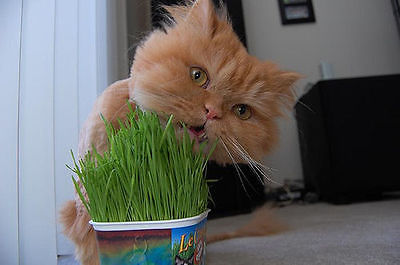Organic Cat Grass - OATS - Great Treat for Feline Digestive System - 200+ Seeds

Price:
$2.99
Shipping:
$4.50
Growing your Pet Grass Have you ever noticed your pet eating grass or nibbling on plants and wondered why? The answer may be as simple as your pet satisfying a natural craving for grass.
Although some pets are more interested in nibbling on grass than others, if yours is one that does, you should be careful about allowing your pet to go outside to munch away. Lawns and other outside plants are often treated with chemicals such as pesticides, fertilizers, or insecticides that are poisonous to animals.
If your pet isn't able to satisfy its craving for grass outside, it may turn to nibbling on your houseplants. Unfortunately, not only might this be undesirable, but it may be deadly. Certain houseplants can be very dangerous or deadly to your pet regardless of whether they have been chemically treated.
A simple and safe solution to satisfy your pet's craving for grass is growing pet grass. Growing pet grass is easy! It grows quickly and is very easy to tend. Growing your own supply of greens will insure that your pet eats only healthy organic grass. How Pet Grass Benefits Your Pet
Adds roughage to your pet's diet providing health benefits such as adding fiber and vitamins to your pet's diet. Fiber and vitamins are vital to the overall health of your pet.
Helps to eliminate hairballs.
Satisfies your pet's craving for greens
Can help keep your pet away from dangerous plants - Providing your pet with pet grass can help prevent them from nibbling on toxic plants.
Pet grass provides pet owners with an affordable and safe way to enrich their pet's diet, eliminate hairballs and keep them safe from toxic plants.
Hairballs
A common medical condition affecting pets is the dreaded hairball. Hairballs are matted or entwined balls of hair that form in your pets stomach or intestines. Hairballs that can't be digested or coughed up account for a large percentage of pet digestive blockages and can make your pet sick or even worse, can be deadly.
How Do Pets Get Hairballs?
Pets get hairballs mainly as a result of grooming themselves. Although most pets seem to have a strong dislike for getting wet, they do like keeping clean and will frequently clean themselves by licking their fur. Their tongue makes it easy for them to snag their hair and swallow it as they groom.
While pets with long hair are more likely to suffer from hairballs, short haired pets may develop hairballs as well. Hairball symptoms include frequently attempting to vomit; changes in eating habits or digestion; and/or a swollen abdomen. If your pet is suffering from any of the above symptoms, it could very well be a pet hairball problem.
Getting Rid Of Hairballs
Although there is no "cure," there are several preventative measures that can be taken to minimize your pet's hairball problem.
Brushing and grooming your pet frequently is one solution that may help prevent hairballs by getting rid of dead hair. The more you brush and groom your pet, the less hair it will swallow when it grooms.
Another solution is growing pet grass for your pet. Pet grass can help eliminate hairballs by adding fiber and vitamins to your pet's diet. A high-fiber diet can help prevent the formation of hairballs.
Hairballs that can't be passed through your pet's digestive system or coughed up may require surgery or other treatment by a veterinarian. When in doubt about the health of your pet, you should consult a qualified veterinarian specifically trained to help keep your pet healthy and safe.
Organic grain seed, enough for 4 - 5 plantings in 4" pot
Planting instructions included with purchase
200 seeds in package
Shipping and Handling Discount - Regular shipping price for first purchase of seeds, additional $.50 for each seed purchase there after. Please do not make payment until you receive an invoice with shipping discount applied.
PLEASE NOTE : WILL NOT SHIP TO FLORIDA, USA
CANNOT SHIP TO FOLLOWING STATES IN USA - FLORIDA, GEORGIA, ALABAMA, TENNESSEE, AND MISSISSIPPI (or any other state with a zip code beginning with a 3)